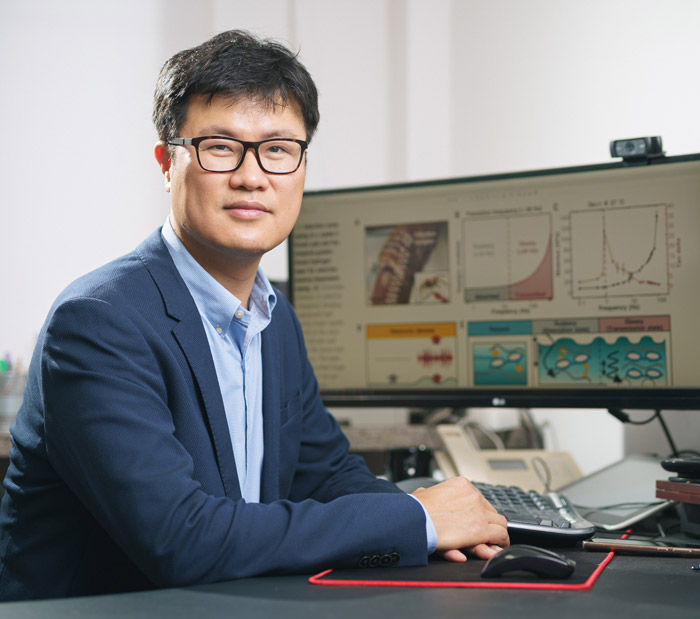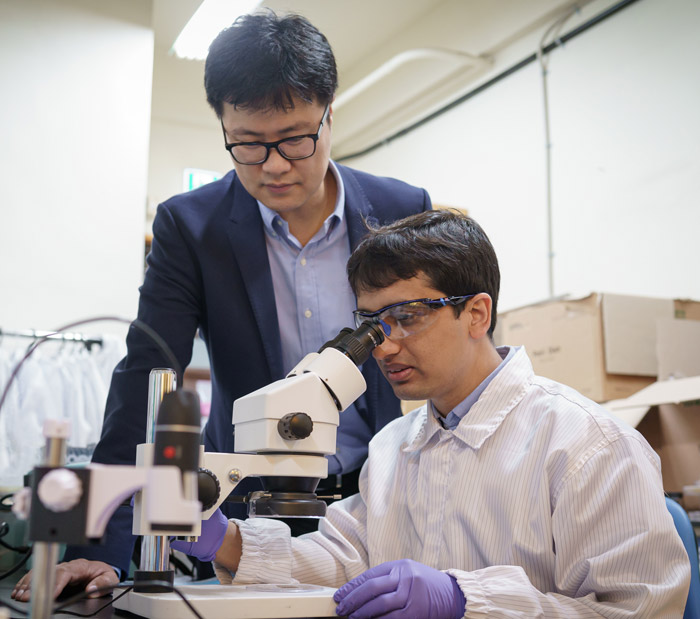Research Stories
Research in Advanced Noise-Selective Damping Hydrogel published in Science
Published in ‘Science’
Research in Advanced Noise-Selective Damping Hydrogel published in Science
Chemical Engineering
Prof.
KIM, TAE IL
SKKU School of Chemical Engineering Professor Tae-il Kim’s research team, led by Dr. Byeong-hak Park, succeeded in developing a damping material that selectively removes external noise by mimicking the pad of a spider’s leg and an electronic device using it.
Recently, bioelectronic devices, including commercially available smartwatches and smartphones, measure important bio-signals in the form of being attached to or inserted into the body. A lot of research has been done to improve device performance for more precise measurement, but as the device performance increases, there is a problem in that when measuring biological signals, interference from various biological signals, including unconscious noise, makes it difficult to distinguish signals. In particular, general noises such as simple walking and movement have a band of less than 30 Hz and are inevitably one of the factors that obstruct the collection of bio-signals. In the current research stage to reduce noise, including commercialized electronic devices, signal processing technology, and machine learning-based signal classification using the same are heavily concentrated. However, this causes signal distortion, requires additional circuitry, and has disadvantages in that it is difficult to change the signal band immediately. In addition, other damping materials have a problem in that they are not optimized for selective bio-signal collection. Therefore, there is a need for a material that passes a bio-signal having a relatively high-frequency band and selectively damps noises having a low-frequency band.
Therefore, the research team tried to solve the above problems with inspiration from natural materials. In the case of spiders, they have very sensitive vibration receptors, so they can sensitively receive vibration signals from enemies, prey, or mates. In particular, the signal can be read well even from external noise such as wind or rain, because the viscoelastic pad located in front of the vibration receptor selectively damps the low-frequency signal.
Based on this, the research team produced a gelatin/chitosan-based viscoelastic hydrogel by simulating the principle of a spider’s pad. In the case of the spider’s pad, it is hypothesized that chitin is composed of a sugar and protein, and in the case of chitin, many hydrogen bonds are formed between adjacent polymer chains, and in the case of proteins, it is hypothesized that a phase change is induced between the chains. In fact, it was confirmed that the gelatin/chitosan-based viscoelastic hydrogel had higher damping energy and selectivity than other damping materials. In addition, it was confirmed that the damping range can be adjusted in real-time from about 1 Hz to 50 Hz when the temperature is externally controlled to 45 degrees.
Using this, combined with a strain sensor, mechanical bio-signals such as neck vibration and heart rate can be read with a high signal-to-noise ratio under noise, and electrical bio-signals such as electrocardiogram and brainwaves can also be stably detected under noise. By using signal processing to obtain a higher signal-to-noise ratio than the existing method that removes noise, it has been proven that the material selectively damping the noise is much more effective than the existing method.
Professor Tae-il Kim said, “This study is a case of materially solving the chronic noise problem of existing electronic devices by mimicking the special mechanical properties of spiders in nature. Selectively reducing external noise can be a more effective method of collecting bio-signals.” In addition, he explained the significance of the study and follow-up research plans. Saying, “by minimizing noise, bio-signal monitoring research has been activated, and it is expected that sensitive signals that were difficult to obtain in real-time will be read out and be of great use in diagnosis and biomedical engineering.”
(Image 1) Selective noise damping in a spider's cuticular pad and the bioinspired gelatin-chitosan hydrogel damper for selective frequency-dependent damping
(Image 2) Demonstration of dynamic noise-damping by using the hydrogel damper for high SNR detection of biophysiological signals


